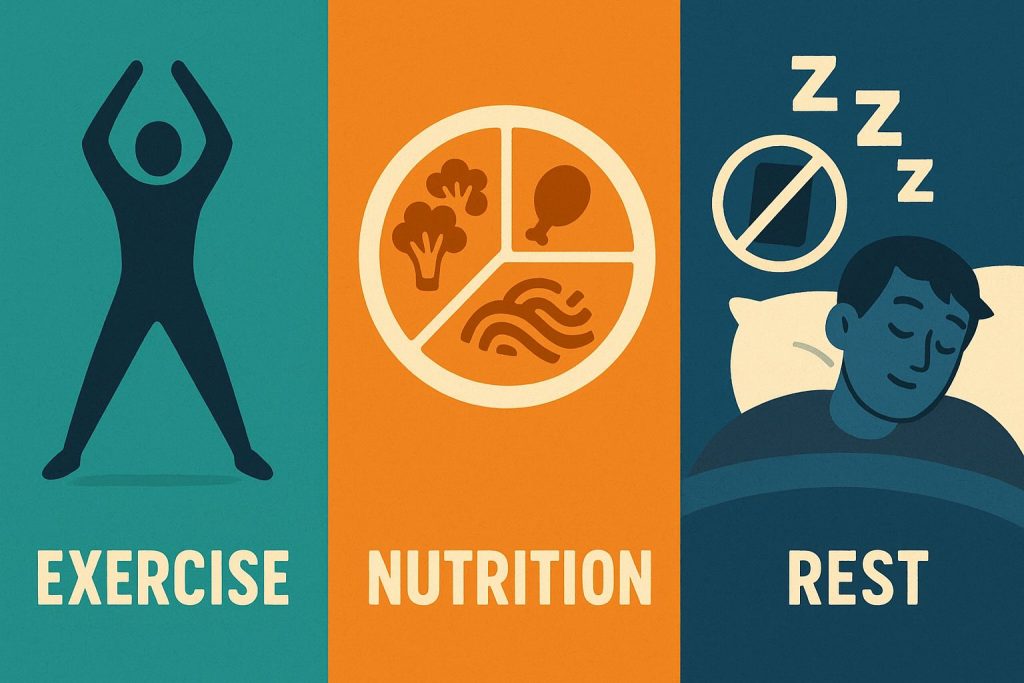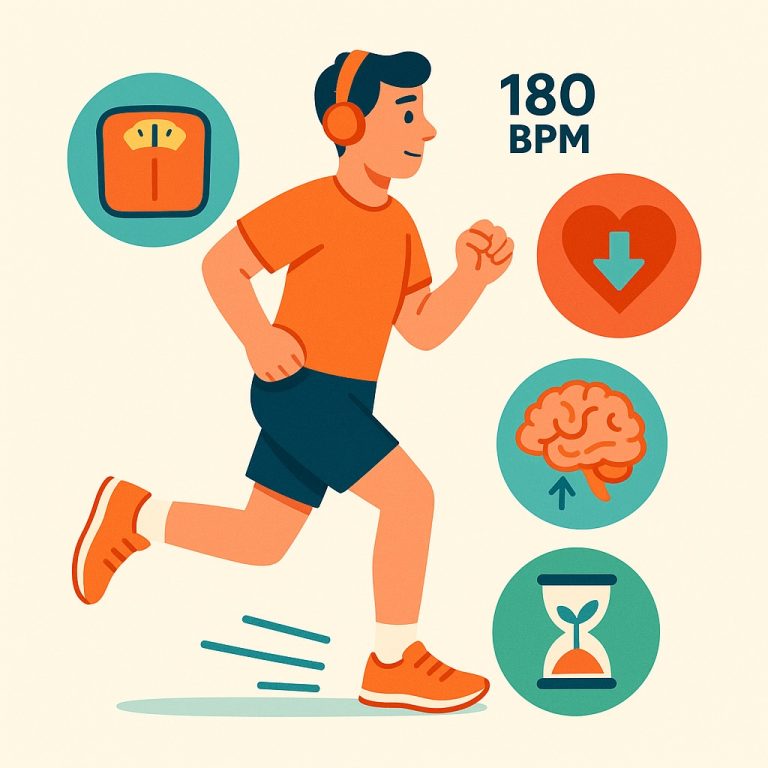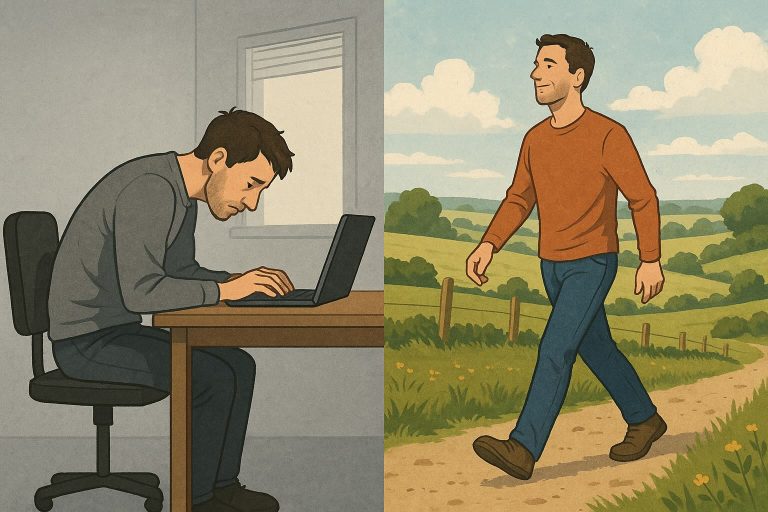
Picture this: you tidy up your desk on Friday, wave goodbye to colleagues, and by Monday morning your inbox is as silent as the moon. Suddenly, you go from “I’m Patrick, the project manager” to “I’m Patrick…?”—a dangling question mark hunting for a new identity. No wonder your heart races at 3 a.m. while worst‑case scenarios conga through your brain.
Financial pressure, shaken self‑worth, disrupted routines, and the nagging uncertainty of “How long will this last?” all collide to spark anxiety. The good news? Anxiety isn’t destiny. The sections below hand you practical, science‑backed ways to steady the ship and find purpose again—no jargon, no fluff, just steps you can start today.
Prioritize Self‑Care and Well‑Being
Exercise, Nutrition, and Rest: The Stress‑Buffer Trio
Think of exercise, balanced meals, and sleep as the three legs of a sturdy tripod. Remove one, and the camera of your mind wobbles. Aim for 150 minutes of moderate activity per week—brisk walking, dancing in the living room, or YouTube cardio sessions. Pair those workouts with “eat the rainbow” plates (veg, lean protein, whole grains). Finally, respect your pillow: sleep restores mood‑regulating brain chemicals; skimping is like pulling the plug on your phone halfway through a software update.

- Quick win: 20 jumping jacks whenever job‑search fatigue creeps in.
- Fuel trick: Half the plate veggies, one‑quarter protein, one‑quarter complex carbs.
- Sleep hack: 11 p.m. device curfew to dodge doom‑scrolling.
Mindfulness, Meditation, and Deep Breathing
If anxiety is a storm cloud, mindfulness is the umbrella. Try the 4‑7‑8 breath: inhale 4 seconds, hold 7, exhale 8—repeat four rounds. Prefer guided help? Free apps like Insight Timer host thousands of meditations.
Hobbies and Leisure to De‑Stress
Flow‑state activities—gardening, sketching, baking bread that looks suspiciously like modern art—pull your mind out of rumination. Schedule hobby time the way you’d schedule an interview; protecting joy is part of the job hunt.
Preventing Burnout: Setting Healthy Boundaries
A 12‑hour “apply‑till‑I‑drop” marathon sounds heroic, but research shows productivity nosedives after hour 6. Use the Pomodoro method: 25 minutes focused work, 5 minutes break. Draft a daily rhythm tying together exercise, applications, networking, and downtime—then follow it like a GPS.
Maintain Social Connections
Leaning on Friends and Family
Anxiety loves isolation; connection starves it. Tell a friend, “I could use a sounding board—it’s not advice I’m after, just an ear.” Adding that single sentence pre‑loads the conversation with clarity and cuts awkwardness.
Joining Peer Support Groups
Search Meetup for “career transition” groups or visit r/Unemployed. Shared stories remind you you’re not alone on Planet Job Hunt.
Staying Socially Active Online and Offline
- Host a board‑game night—cheap, cheerful, distraction‑free.
- Join a virtual coworking room (e.g. Focusmate) to mimic office camaraderie.
- Volunteer at community events—you’ll widen your network while doing good.
Stay Active and Purposeful
Creating a Structured Daily Routine
Without a timetable, days blur like watercolors in the rain. Draft a skeleton schedule (template download here) covering wake‑up, exercise, job tasks, meals, and wind‑down. Structure signals your brain: “I’m still in control.”
Volunteering and Part‑Time Roles
Giving back flips the script from “I’m lacking” to “I’m contributing.” Food banks, animal shelters, and mentoring programs welcome short‑term help—and you gain fresh bullet points for your résumé.
Community Involvement for Meaning
Humans are herd animals; purpose often sprouts in community soil. Join a neighborhood cleanup, coach youth sports, or attend city‑council sessions—mini acts of citizenship that spark belonging.
Upskilling Through Online Courses
Digital skill gaps shrink faster than a smartphone battery. Coursera and Khan Academy serve free courses, while Google Career Certificates fast‑track you into IT support or UX design. Set a SMART goal: “Finish Excel Basics in 14 days, 30 minutes daily.”
Navigate Financial Pressure and Rapid Re‑Entry to the Workforce
Being the sole—or primary—breadwinner turns ordinary unemployment stress into a high‑stakes balancing act. This section gives you concrete ways to ease the money strain while getting back to paid work as swiftly as possible—even if that means pivoting fields or accepting a lower starting salary.
Triaging Household Expenses and Negotiating Bills
- Sort costs by criticality. Label every outgoing dollar as essential, nice‑to‑have, or delayable. Shelter, utilities, food, and health premiums stay in tier A; streaming services, take‑out, and hobby subscriptions shift to tier C.
- Open the conversation with creditors early. Many lenders, landlords, and utility companies grant hardship deferments or reduced payment plans when you call before you’re late. A five‑minute phone call can buy you 30‑to‑90 days of breathing room.
- Automate what remains. Late fees are stealth taxes on unemployment. Setting up auto‑pay for pared‑down essentials helps you avoid them and reduces mental load.
Budget checkpoint: If you still face a gap, calculate your “bare‑bones survival number” (essentials only). That figure becomes your short‑term income target rather than your previous salary.
Setting Flexible Salary Expectations—Without Selling Yourself Short
- Research today’s range, not last year’s peak. Use sites like Glassdoor and levels.fyi filtered by current postings to anchor your expectations to the present market.
- Frame flexibility as collaboration. In interviews say, “Given the economic climate, my priority is stable work where I can add value quickly. I’m open to a competitive package that fits your current budget.” This signals realism without desperation.
- Negotiate growth triggers. If you accept a lower entry salary, request a written review at 6 or 9 months tied to specific metrics. That turns a short‑term compromise into a performance‑based springboard.
Short‑Term Income Bridges: Gig Work, Temp Roles, Freelancing
| Option | Typical On‑Ramp Time | Pros | Cons |
|---|---|---|---|
| Freelance platforms (Upwork, Fiverr) | ~1 week to land first gig | Remote, flexible, taps existing skills | Race‑to‑the‑bottom pricing, need reviews |
| Temp agencies | 2–5 days | Fast placement, sometimes benefits | Often on‑site, variable schedules |
| Gig apps (ride‑share, delivery) | 24–48 h background check | Instant cash‑flow, minimal onboarding | Vehicle costs, physical wear |
Pro tip: Combine a flexible gig (evenings) with daytime job‑search efforts. That dual strategy protects your bank balance without derailing your long‑term career move.
Pivoting Fields: Spot and Sell Your Transferable Skills
- Inventory soft and hard skills. List tools, technologies, methodologies, and people skills you used in prior roles.
- Map overlaps. Use job ads in adjacent industries to spot recurring requirements you already meet (e.g., project management → operations coordinator).
- Craft a two‑sentence pivot story. Example: “After 8 years managing supply‑chain timelines, I’m redirecting my planning expertise to healthcare logistics where precision and cost‑control are equally mission‑critical.”
- Bridge any gaps fast. Free micro‑credentials (Google Skillshop, LinkedIn Learning) can plug minor knowledge holes and prove commitment.
Manage Anxiety and Negative Thoughts
Acknowledging and Validating Emotions
Emotions are messengers, not enemies. Try the “Name it to tame it” trick: write “I feel worried and angry” in a journal. Labeling activates the brain’s rational centers, cooling the emotional wildfire.
Challenging Negative Self‑Talk
Grab a sheet and make two columns: Thought vs. Evidence. If your brain says, “I’ll never get hired,” counter with data: “I’ve landed three roles before; my LinkedIn skill badge completion rate is 80 %.” That reframes catastrophic thinking into a factual debate—and anxiety usually loses.
Practising Self‑Compassion and Gratitude
Talk to yourself the way you’d comfort a friend. Add a three‑item gratitude list to your bedtime routine—small wins count (fresh coffee, supportive text, new playlist).
Focusing on What You Can Control
Draw two circles: one for controllables (CV layout, daily routine), one for uncontrollables (economy, other applicants). When worry invades, ask, “Which circle does this belong in?” Then act or release.
Reframe Your Career Narrative (Narrative Therapy)
Separate Self‑Worth from Job Status
A paycheck isn’t a personality. List five strengths that exist whether or not HR calls back—creativity, patience, humor, whatever makes you shine. During my own layoff in 2020, I volunteered to mentor coding boot‑camp grads. I wasn’t earning, but I was adding value, and the mentees’ progress proved I still mattered.
Draft Your “Preferred Future” Storyline
Close your eyes and jump five years forward. Where are you working? How do mornings feel? Write that scene in present tense (“I lead a small design team, sipping coffee while brainstorming bold campaigns”). Back‑cast three milestones that bridge today to that vision—perhaps an online UX course, a freelance stint, a networking conference.
Collect Past Wins to Fuel Confidence
Create a “Victory Vault.” Gather emails praising your work, project screenshots, customer testimonials. Scrolling through tangible evidence of past success reminds you competence doesn’t vanish alongside job titles.
Seek Professional Help When Needed
Recognising When It’s Time for Therapy or Counselling
If anxiety hijacks sleep for two straight weeks, if panic attacks strike, or if you lose interest in activities you used to love, consider therapy. A therapist is a coach for the mind, not a judge.
Understanding Medication Options
Selective Serotonin Reuptake Inhibitors (SSRIs) like sertraline can ease chronic anxiety. They’re tools, not crutches, best discussed with a qualified physician who can weigh benefits and side effects.
Finding Affordable Mental-Health Resources
- Hotlines: In the U.S., call 988; in the U.K., Samaritans at 116 123; elsewhere, see Find A Helpline.
- Sliding-scale clinics: Search “community mental health center” in your city.
- Apps: Woebot (AI CBT coach, free trial), Sanvello (mood tracking + guided paths).
Key Takeaways and Next Steps
Unemployment can feel like life pressed the pause button, but anxiety doesn’t have to fill the silence. Move your body, feed it well, and let it rest. Huddle with friends. Plant purpose seeds through volunteering and learning. When worry shouts, counter with facts—and remember, your worth predates any résumé line.
If the mental fog refuses to lift, reach out: therapist, hotline, or a trusted mentor. You are not broken—you’re in transition. Keep planting steps, one after another, and soon enough you’ll walk into the next chapter stronger than before.




